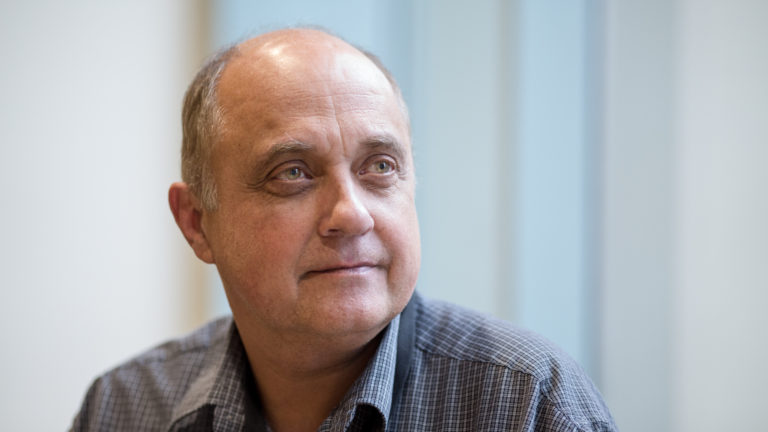ABOVE: UNIVERSITY OF OTAGO, NADIA CHAUDHRI, LILY PEACOCK, ETH ZURICH, CHRISTIAN FLEMMING/LINDAU NOBEL LAUREATE MEETINGS, CHARLES WARDEN/ETSU, STEVE HAMBUCHEN, MOUNT SINAI HEALTH SYSTEM, DONALD JOHANSON, CDC
Phil Bishop (1958-2021)

Phil Bishop, a zoologist and global champion for amphibian conservation, died on January 23 after a brief illness. He was 63 years old.
Throughout his career, Bishop was passionate about discovering threats to amphibians around the globe. He published more than 100 papers, with his research ranging from the social significance of a chorus of frog mating calls, to disease, to fragmented habitats.
“His work for amphibians does not end,” the Amphibian Survival Alliance, where Bishop served as chief science officer, said in a statement after his passing. “The flame of his life and passion has not been extinguished but will continue to shine brighter in everything we do from this day forward.”
Nadia Chaudhri (1978-2021)

Nadia Chaudhri, a neuroscientist who investigated the underlying mechanisms of addiction and relapse, died on October 5 of ovarian cancer. She was 43.
Chaudhri investigated the processes behind drug and alcohol addiction from molecular, neural, and psychological standpoints. When she was diagnosed with advanced ovarian cancer, which proved resistant to treatment, she spoke about the beauty of life while knowing hers was coming to an end. She created an endowment to help underrepresented students studying neuroscience at her institution, Concordia University in Montreal, and posted fundraising videos on Twitter from the hospital. At the time of her death, she had raised more than 600,000 Canadian dollars.
“Girls just wanna have fun & that’s what my bestie & I are doing,” Chaudhri tweeted in her final video, showing her dancing in her hospital bed to Cyndi Lauper. “Your donations to the Nadia Chaudhri Wingspan Award have blown me away. Words can’t convey my gratitude.”
Markus Dyck (1960s-2021)

Markus Dyck, a prominent polar bear researcher known for working alongside Indigenous communities while out in the field, died in a helicopter crash on April 25. Friends estimated he was in his early 50s.
Dyck became enamored with polar bears when his military service brought him to Canada. After emigrating from Germany, he joined Nunavut’s Department of the Environment and studied many facets of polar bear conservation, often traveling to remote field locations. Rather than entering the hunting grounds of First Nations people without permission, he worked with those communities to understand the bears’ movements and behavior and established ecotourism that supported the people and animals of the area.
“We always knew the work was dangerous,” Dyck’s former colleague Lily Peacock tells The Scientist, “but it was what had to be done to generate the data for appropriate management of the populations and research.”
Richard Ernst (1933-2021)

Richard Ernst, a Nobel laureate and chemist whose work with nuclear magnetic resonance (NMR) technology led to the development of magnetic resonance imaging (MRI), died on June 4. He was 87.
At the onset of Ernst’s career, NMR fields were not uniform, and the same sample could give drastically different readings depending on where the sample was located in the machine. Throughout the 1960s, he was able to harness new electromagnetic technology to create readings that were consistant, stable, and minimized background noise. He was awarded the Nobel Prize in Chemistry in 1991.
In his Nobel Prize autobiography, Ernst wrote about his gratitude toward his wife for staying “married to a selfish work-addict with an unpredictable temper,” and to his three children, none of whom went into science. “I am not surprised that they show no intention to follow in my footsteps, although if I had a second chance myself, I would certainly try to repeat my present career.”
Edmond Fischer (1920-2021)
Biochemist Edmond Fischer, a Nobel laureate who codiscovered the mechanism of reversible phosphorylation, died on August 27. He was 101.
As a new researcher in the early 1950s at the University of Washington, Fischer collaborated with Edwin Krebs to study the liver enzyme glycogen phosphorylase. They learned that this enzyme was able to quickly convert glycogen to glucose in response to “fight or flight” scenarios. Fischer and Krebs were awarded the Nobel Prize in Physiology or Medicine in 1992 for their discovery.
“He truly inspired many young scientists for the ‘beauty of science’ as he once put it himself,” Countess Bettina Bernadotte, president of the council for Lindau Nobel Laureate Meetings, said in a press release following his passing.
Thomas Hodge (1952-2021)

Thomas Hodge, an immunologist who came out of retirement to work on the SARS-CoV-2 pandemic, died from complications of COVID-19 on July 31. He was 69.
In the 1980s, Hodge came to the Centers of Disease Control and Prevention (CDC), where he worked in leadership roles within the HIV/AIDS division until 2005. Shortly after the onset of the COVID-19 pandemic, Hodge worked to help connect researchers with each other. He was medically ineligible for the vaccine and fell ill from the virus in July. Still, he kept working via Zoom from his hospital bed up until days before his death.
Muriel Lezak (1927-2021)

Muriel Lezak, a neuropsychologist who created the first comprehensive guide to brain injuries, died on October 6. She was 94.
Lezak’s career as a psychologist took a turn toward neuroscience as she worked with returning Vietnam veterans and their families. The war had created drastic changes in some of her patients’ personalities and behaviors, and unable to find a book that compiled all of the research connecting brain trauma and outward changes, she wrote one herself in 1976. She was also an outspoken voice for concussion prevention in youth sports going back to the early 1980s, long before the long-term consequences of the injuries were commonly acknowledged.
“I think sports need to change. Unfortunately, these contact sports are really dangerous,” Lezak said in a 2012 profile in UChicago Magazine. “For the sake of our own entertainment, we’re asking a lot of these young people.”
Barbara Murphy (1964-2021)

Barbara Murphy, a nephrologist whose work improved the outcomes of kidney transplantations, died of glioblastoma on June 30. She was 56.
Murphy’s work investigated the link between HIV and kidney disease and led to enabling HIV-positive individuals to donate kidneys to others with the virus. She also identified 13 genes responsible for the development of fibrosis, a common reason kidney transplants fail. This not only helped predict transplantation outcomes, but could lay the foundation for one day developing medications to suppress fibrosis formation.
“Barbara’s commitment to transplantation inspired so many of us, and her passing has left a huge void in our community,” a statement from the American Society of Transplantation read.
Maurice Taieb (1935-2021)

Maurice Taieb, a geologist who discovered formations rich in fossils telling the story of human evolution, died on July 23. He was 86.
While in Ethiopia in 1968, Taieb discovered a trove of snail fossils. Because of the location of tectonic plates pushing ancient rocks to the surface, he surmised that many other fossils could be found there and encouraged researchers to come dig. In 1974, Taieb was working with paleoanthropologists Donald Johanson and Yves Coppens when they discovered 3.2-million-year-old hominin bones. The specimen, dubbed “Lucy,” belonged to Australopithecus afarensis, which had many features of early apes but was likely bipedal.
Taieb was “an intrepid explorer and one of the most generous human beings I have ever known,” Johanson, who identified Lucy’s bones, told The Scientist. “His early geological field work in the Afar Region of Ethiopia prompted paleoanthropologists, biologists, archaeologists, and geologists to follow in his footsteps.”
Sharif Zaki (1955-2021)

Sherif Zaki, a pathologist at the CDC for more than 30 years, died unexpectedly on November 21. He was 65 years old.
Zaki’s career at the CDC began in 1988. His lab uncovered the pathogens behind many outbreaks, including flu strains, SARS, anthrax, Ebola, Zika, and West Nile. This quick identification allowed public health experts to begin mitigating the risk to humans and bringing the outbreaks to an end.
“During his tenure at the agency, Dr. Zaki was critical in diagnosing unexplained illness and outbreaks that allowed CDC and public health to respond more quickly and save lives,” CDC Director Rochelle Walensky wrote in a statement to The Scientist, adding that his “legacy will live on through his extraordinary work done at CDC to protect the public’s health.”
Click here for the full list of obituaries.






